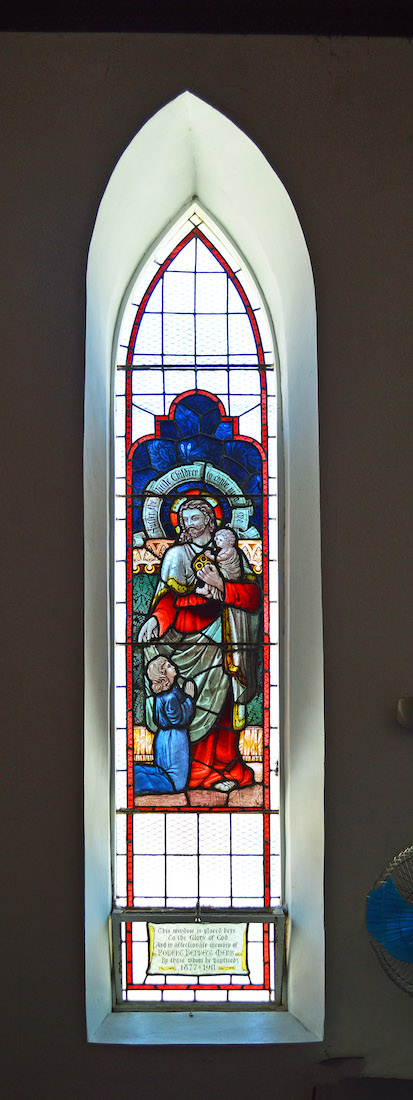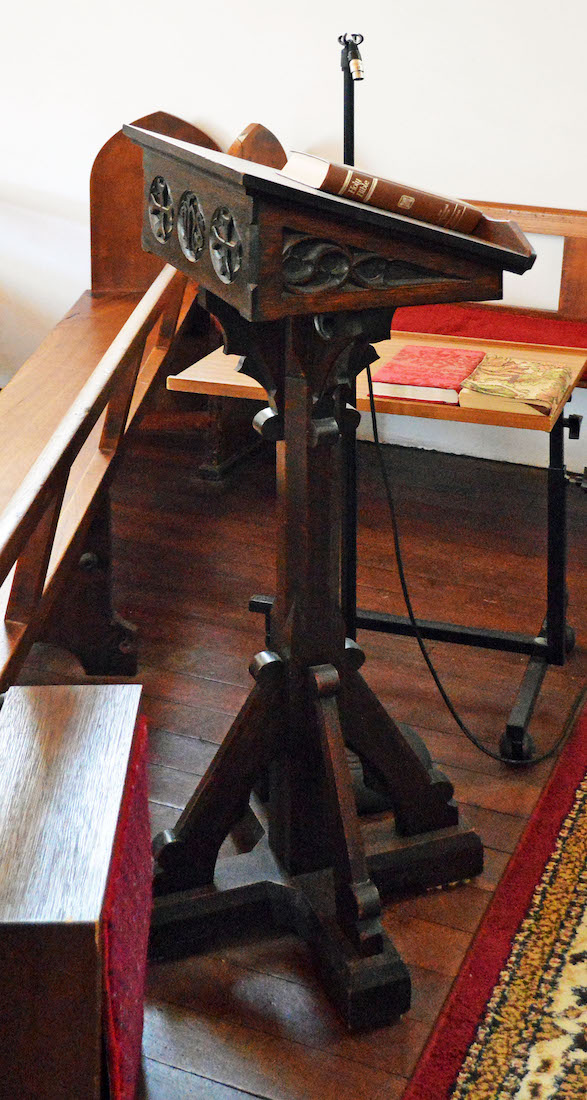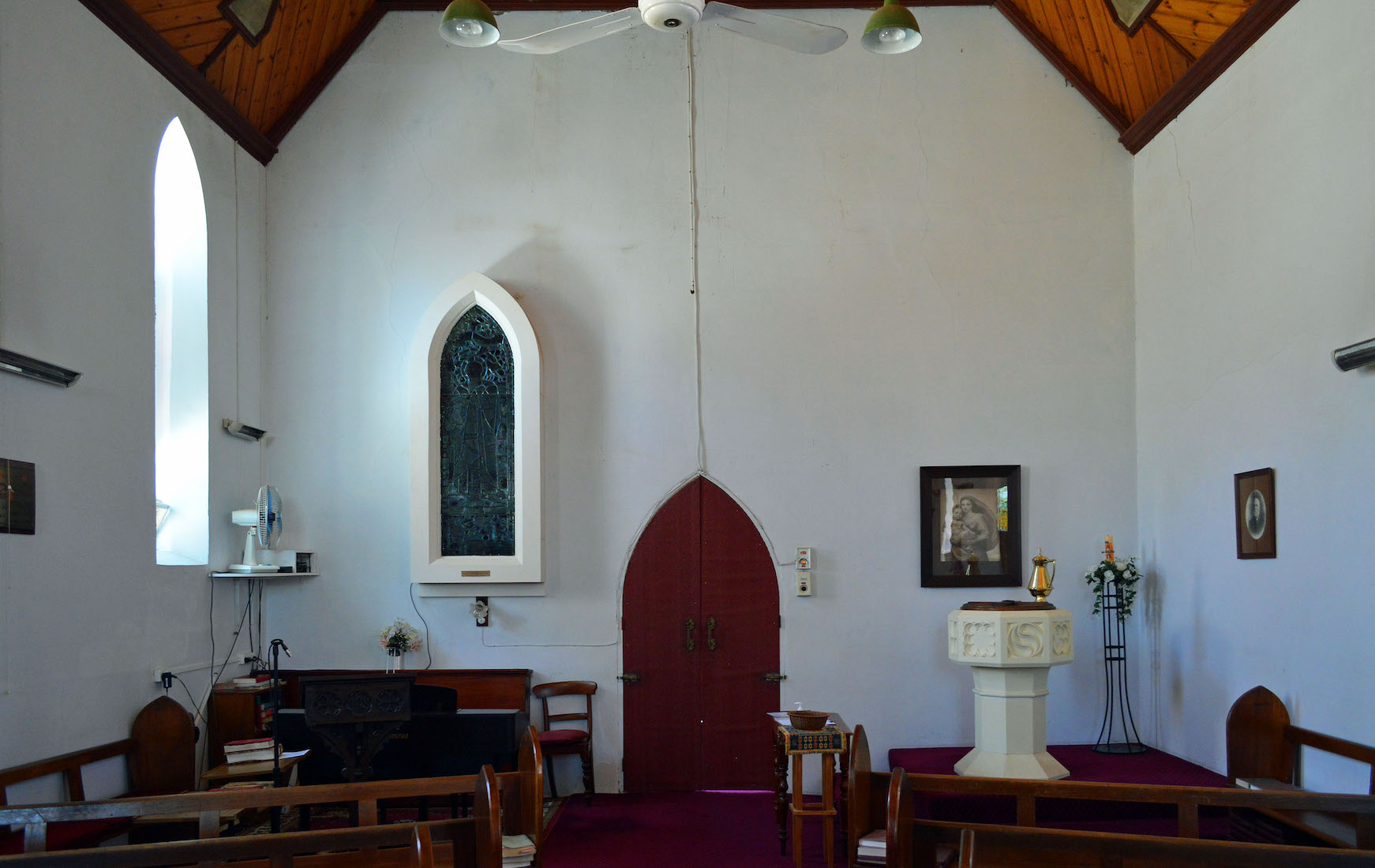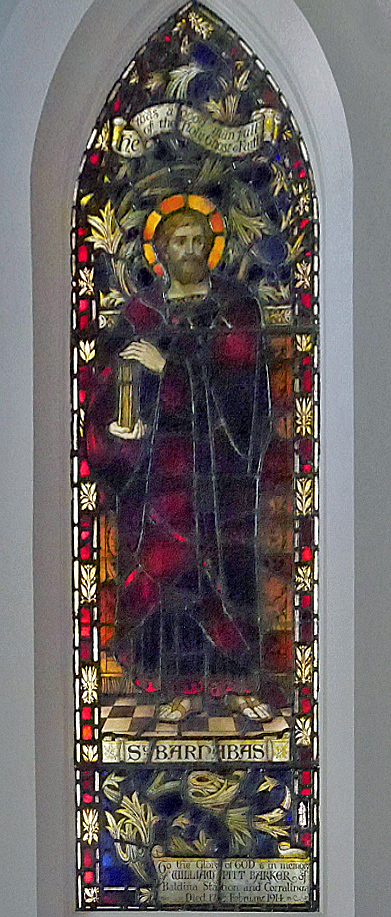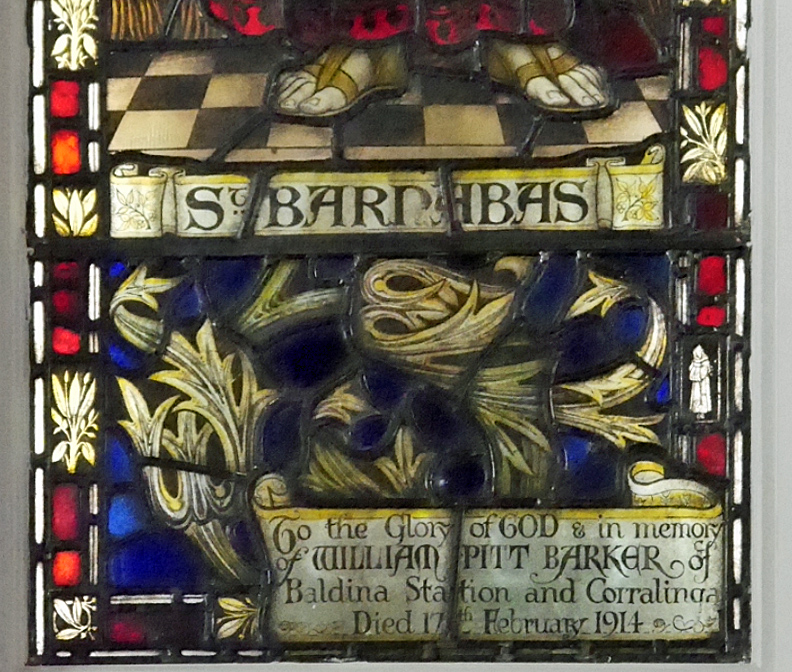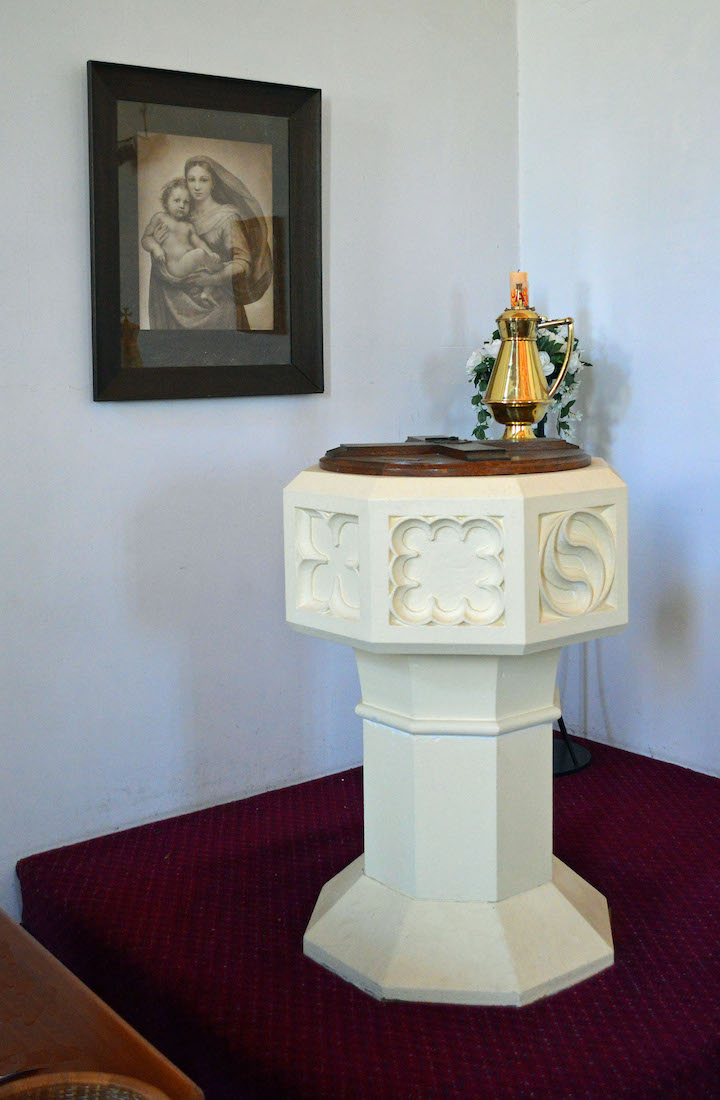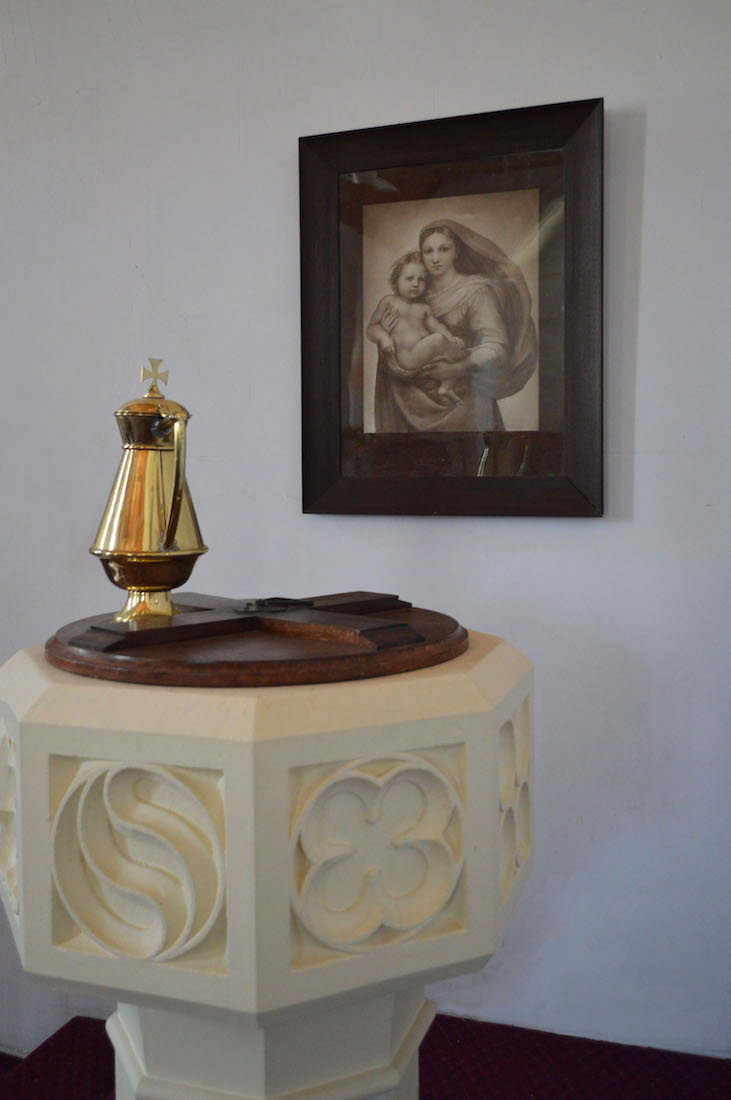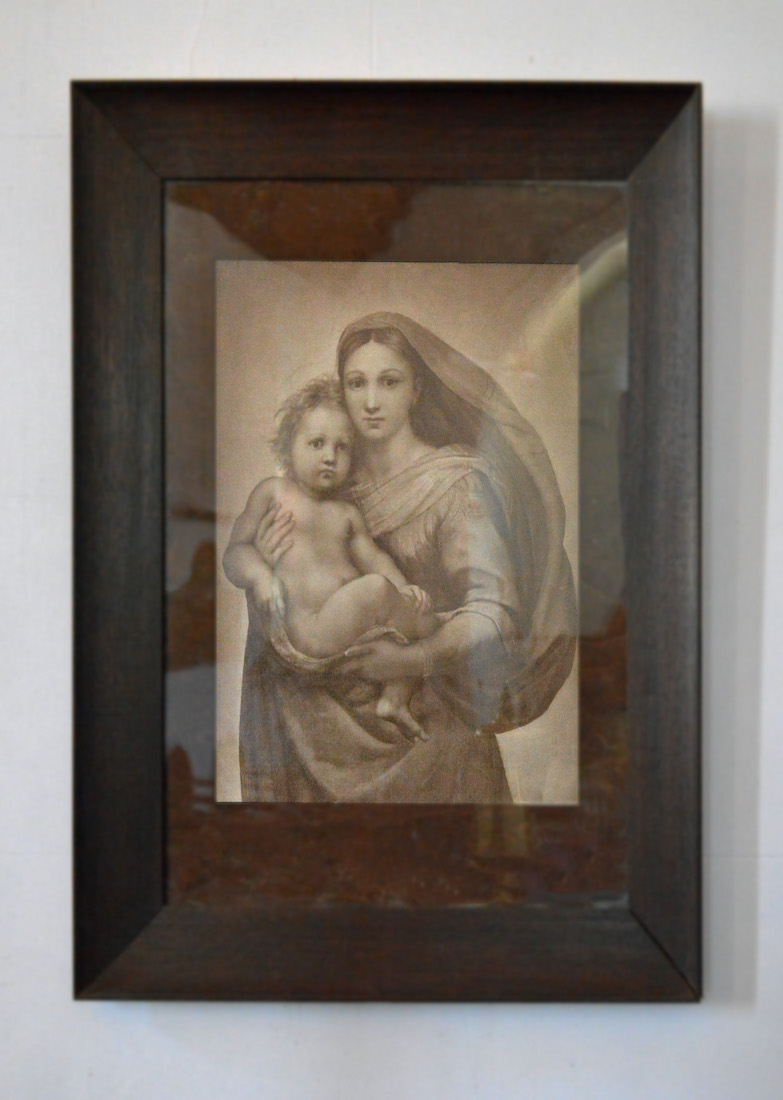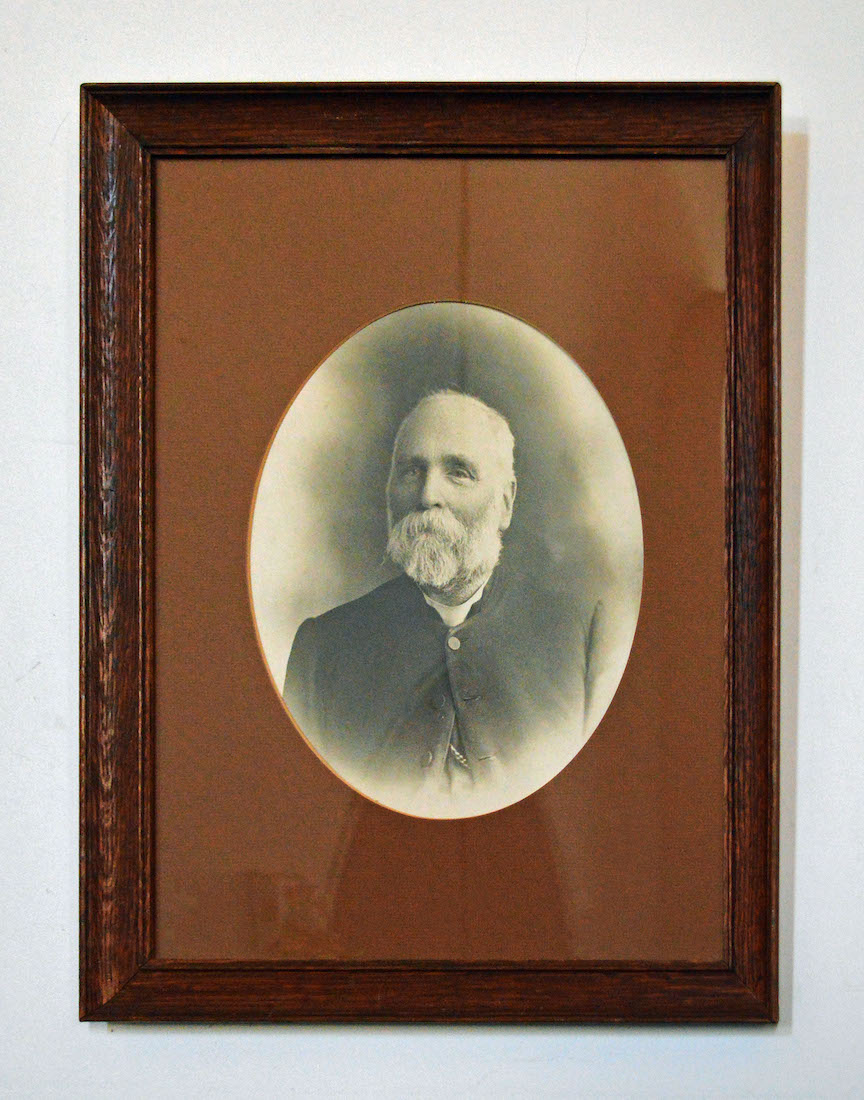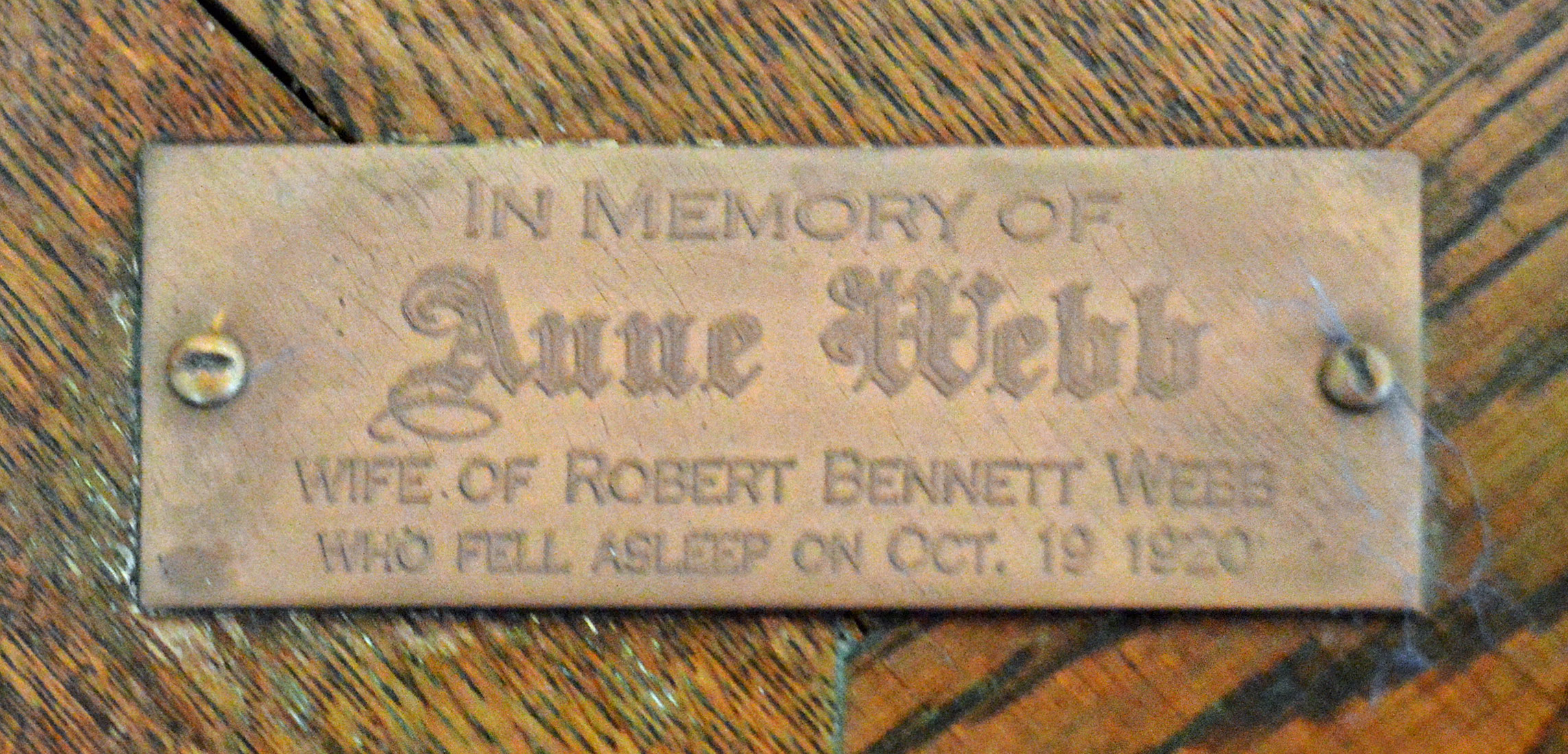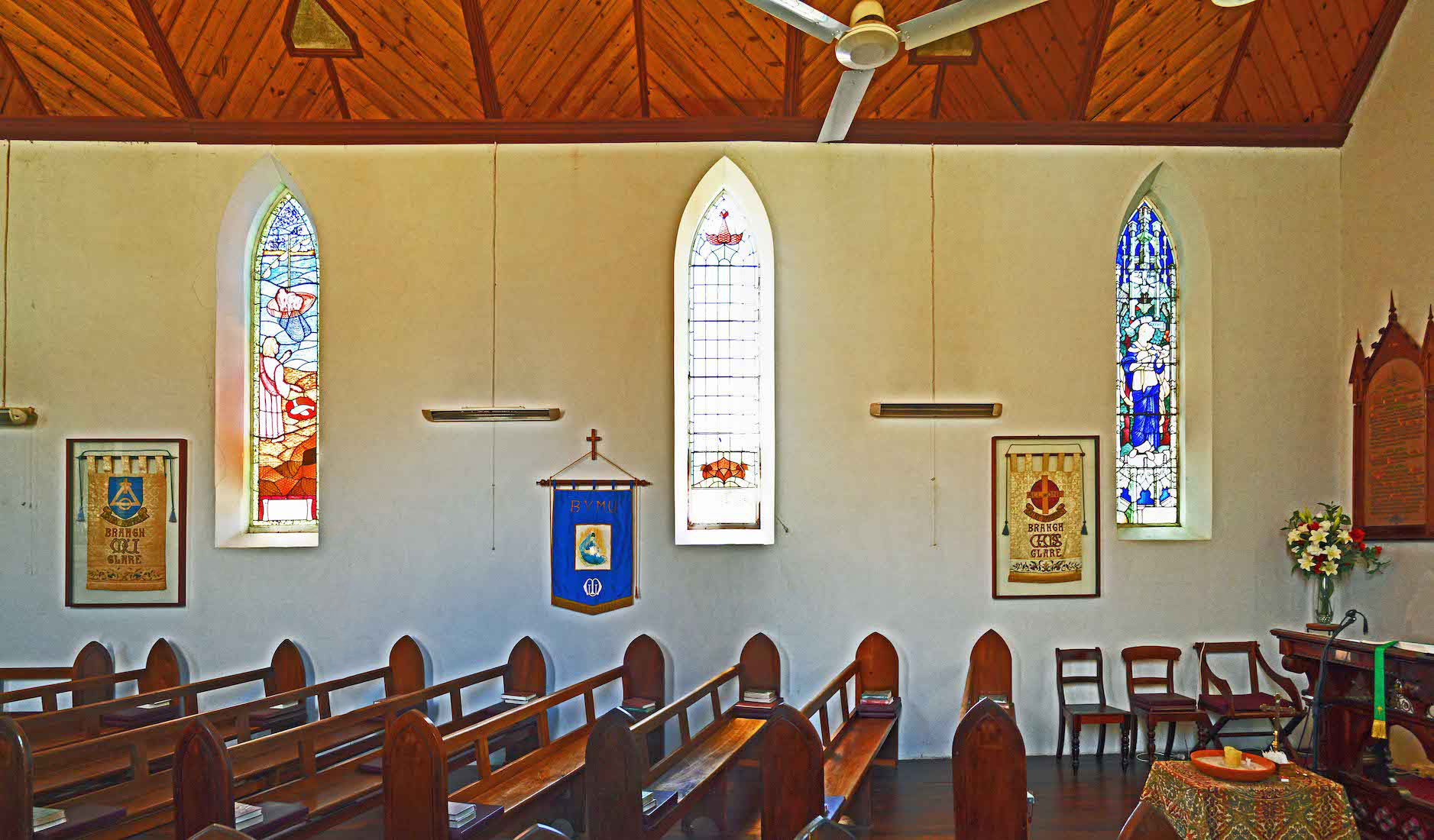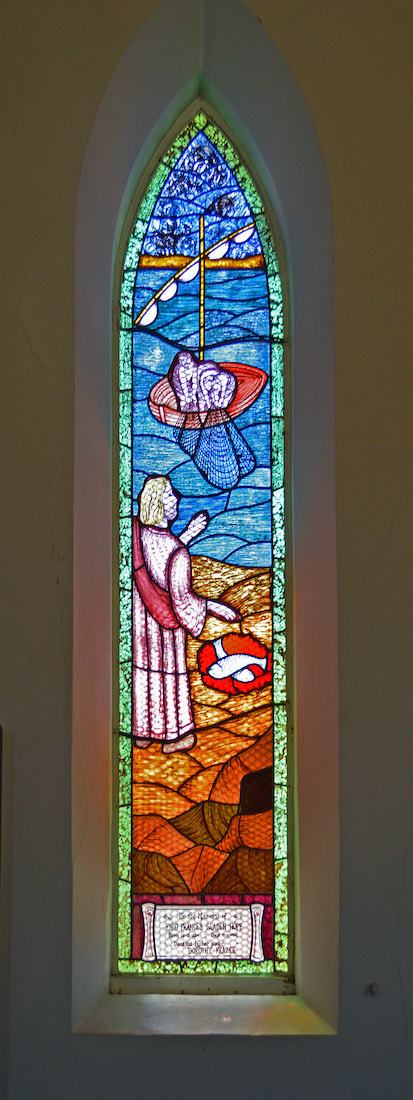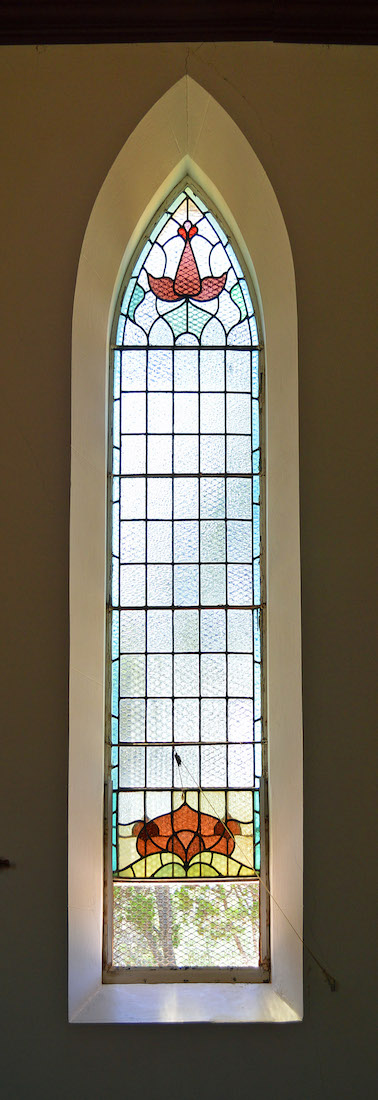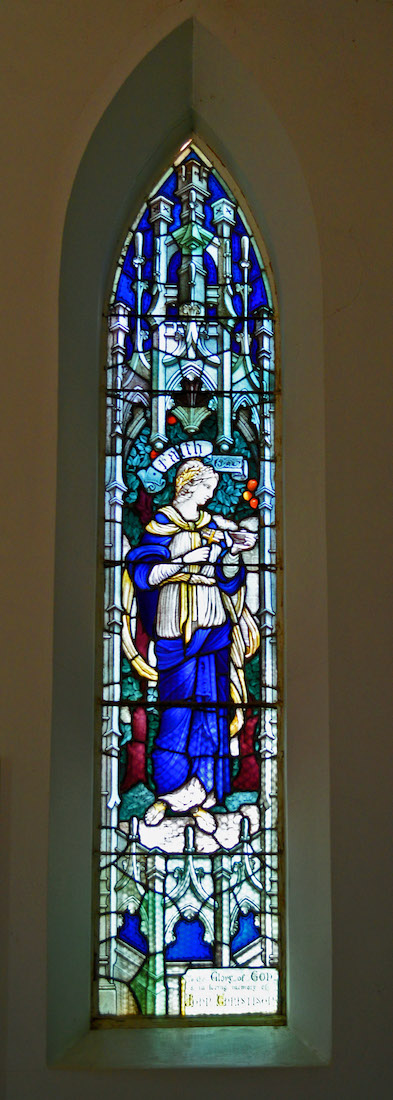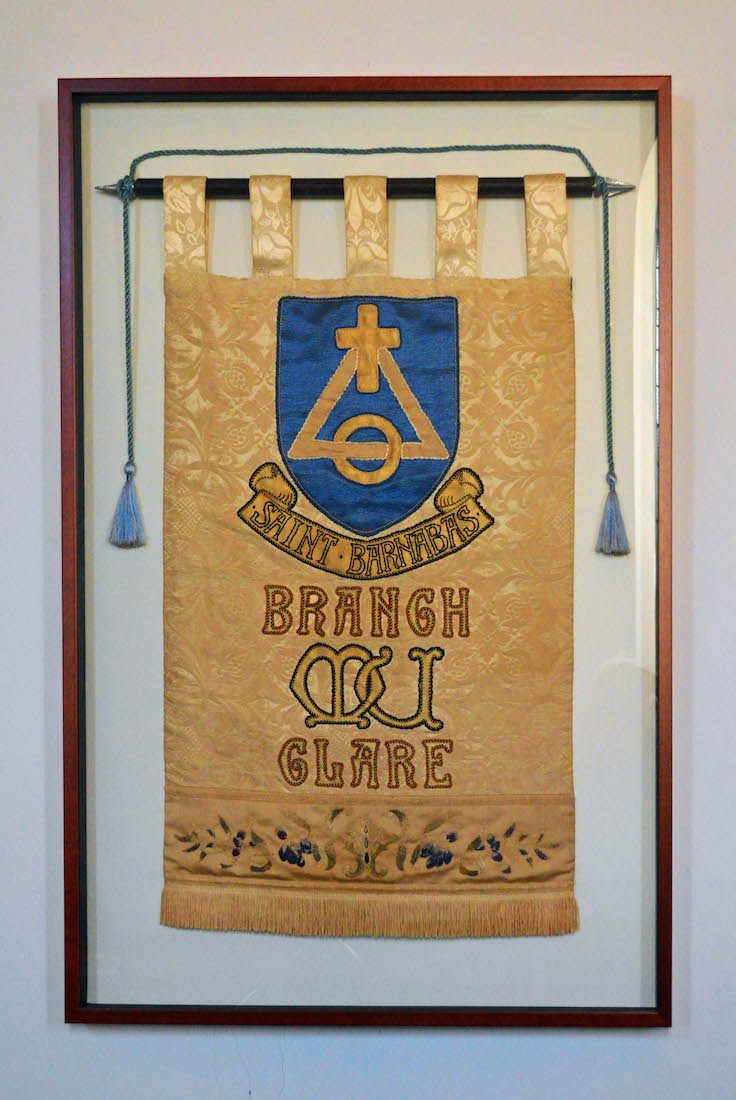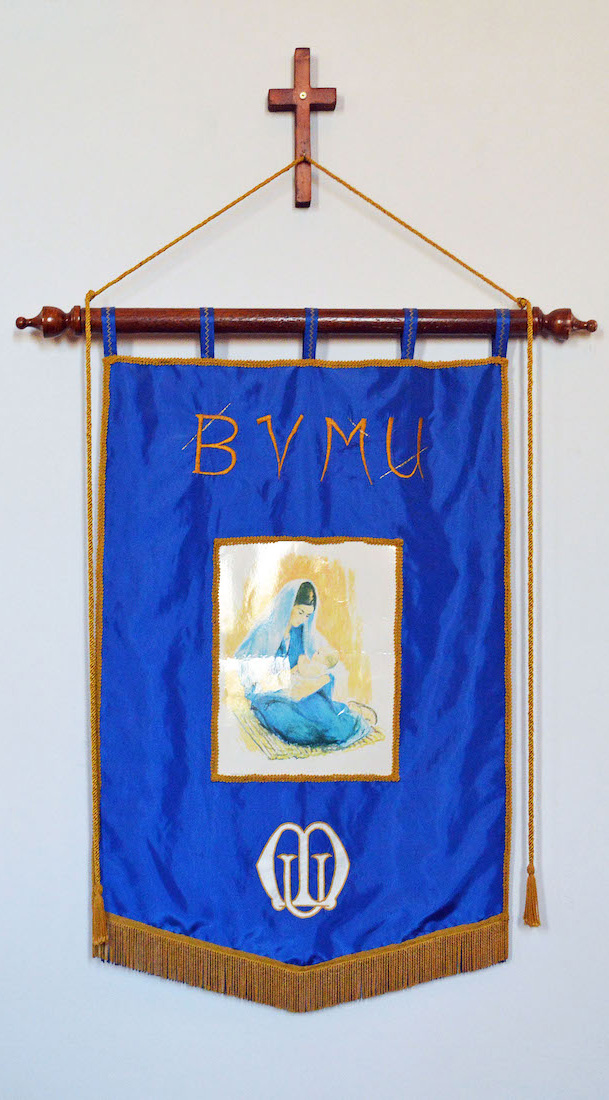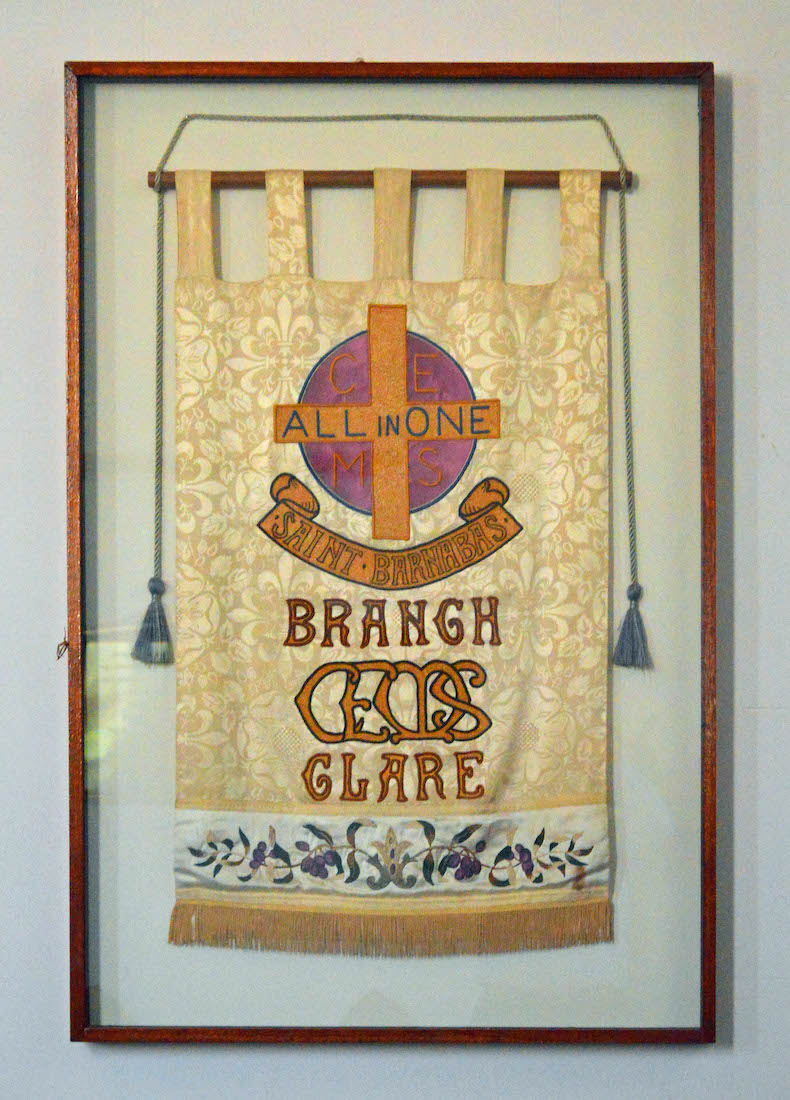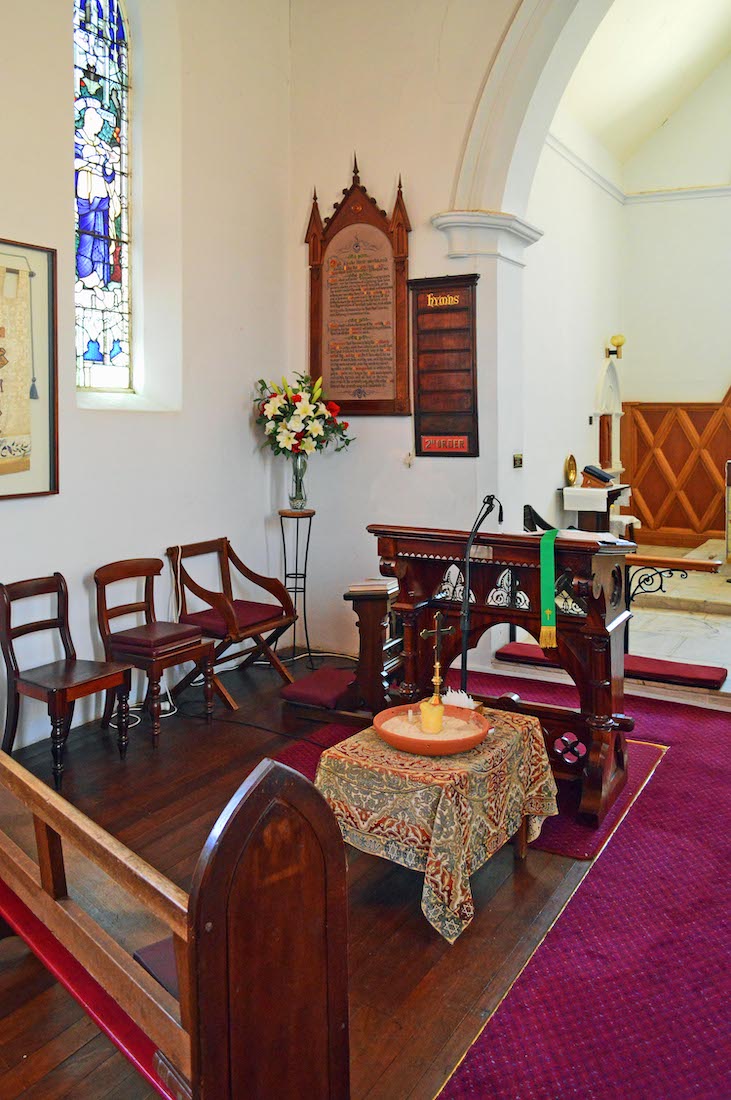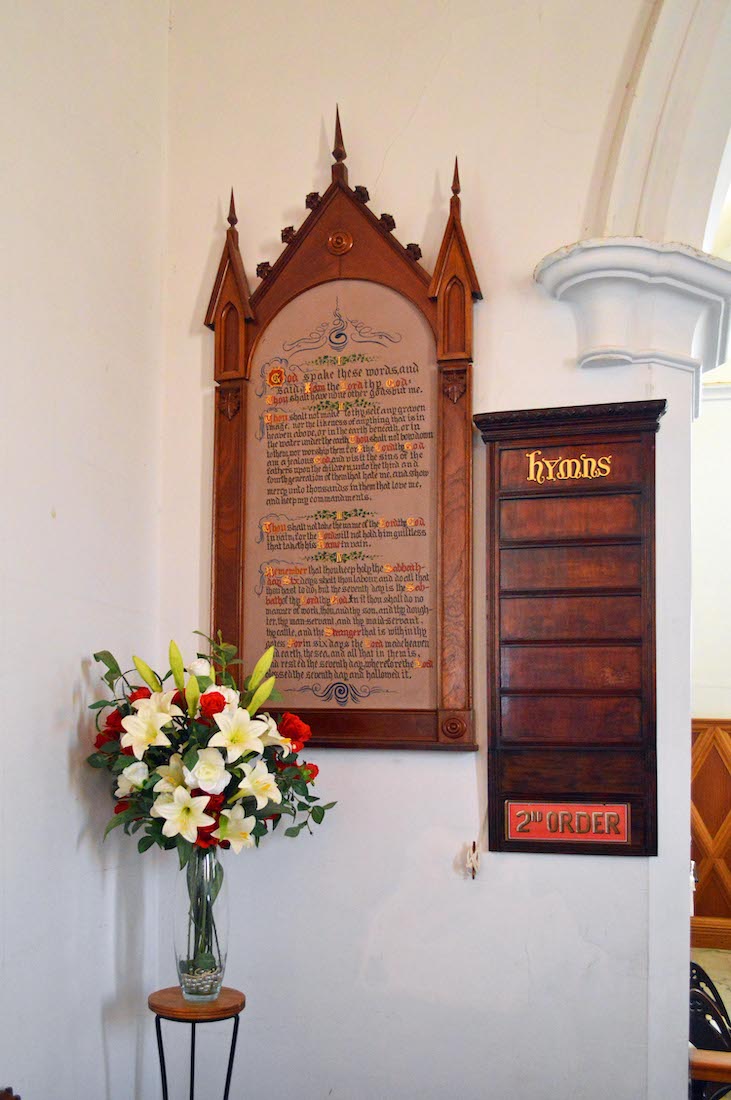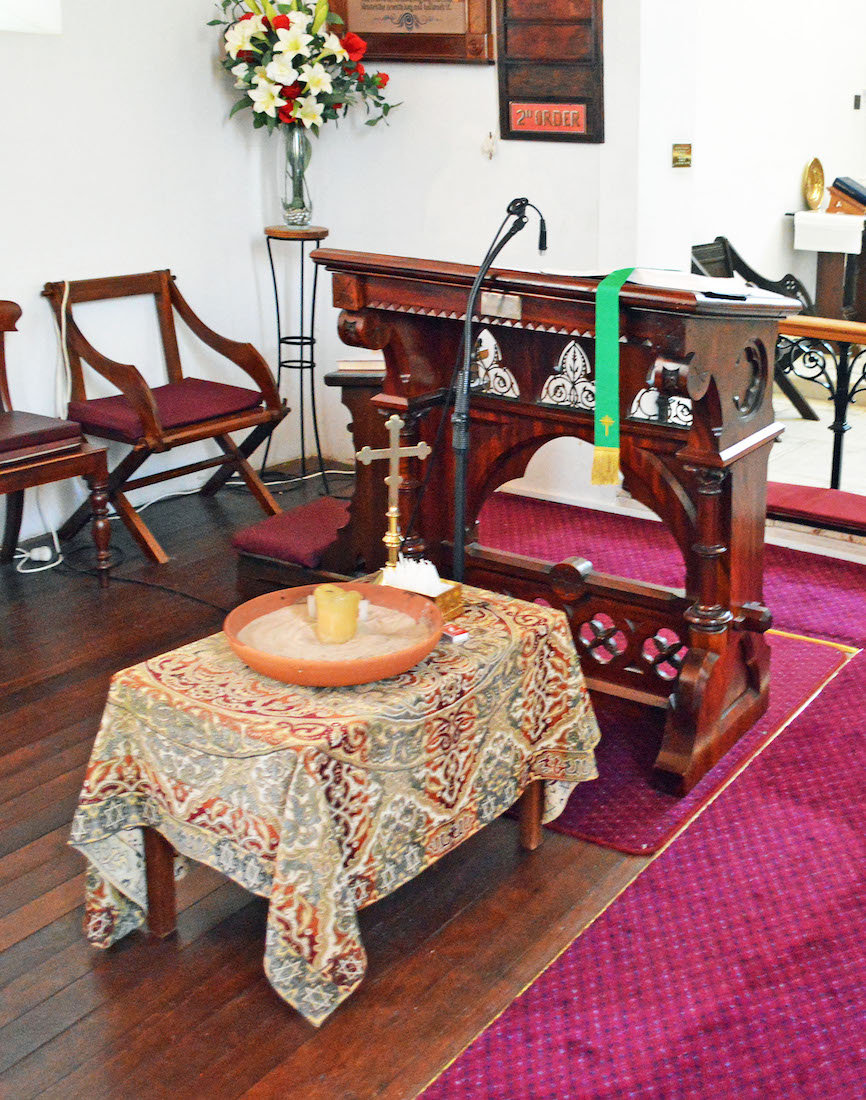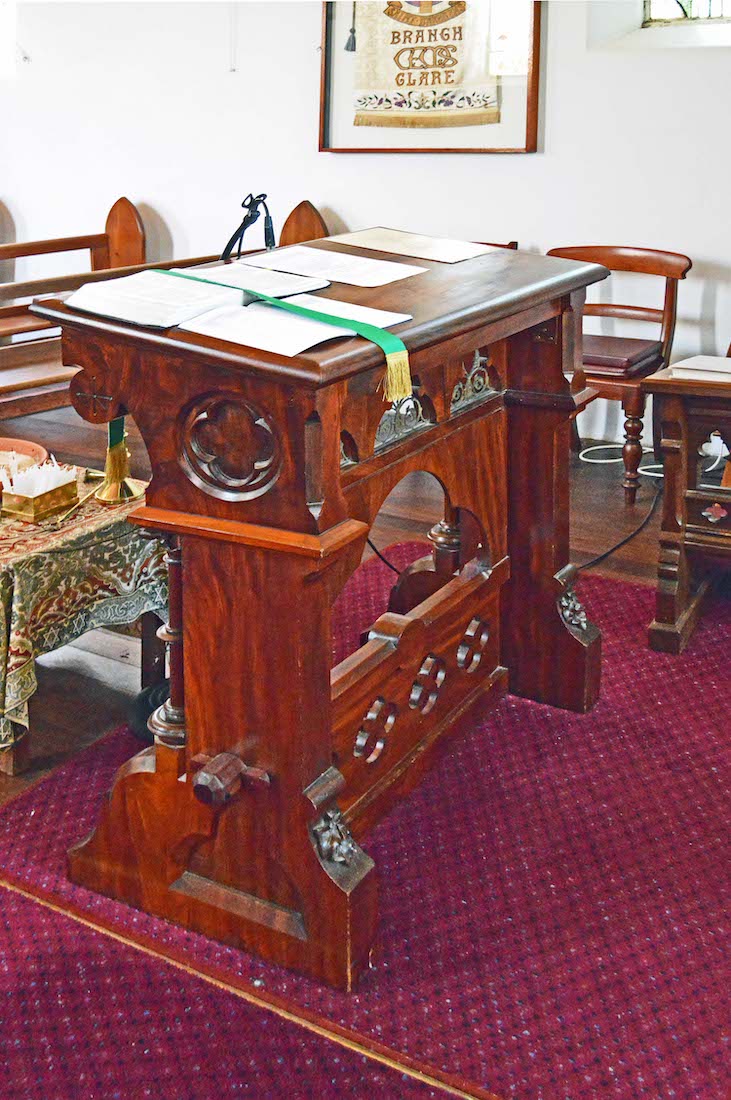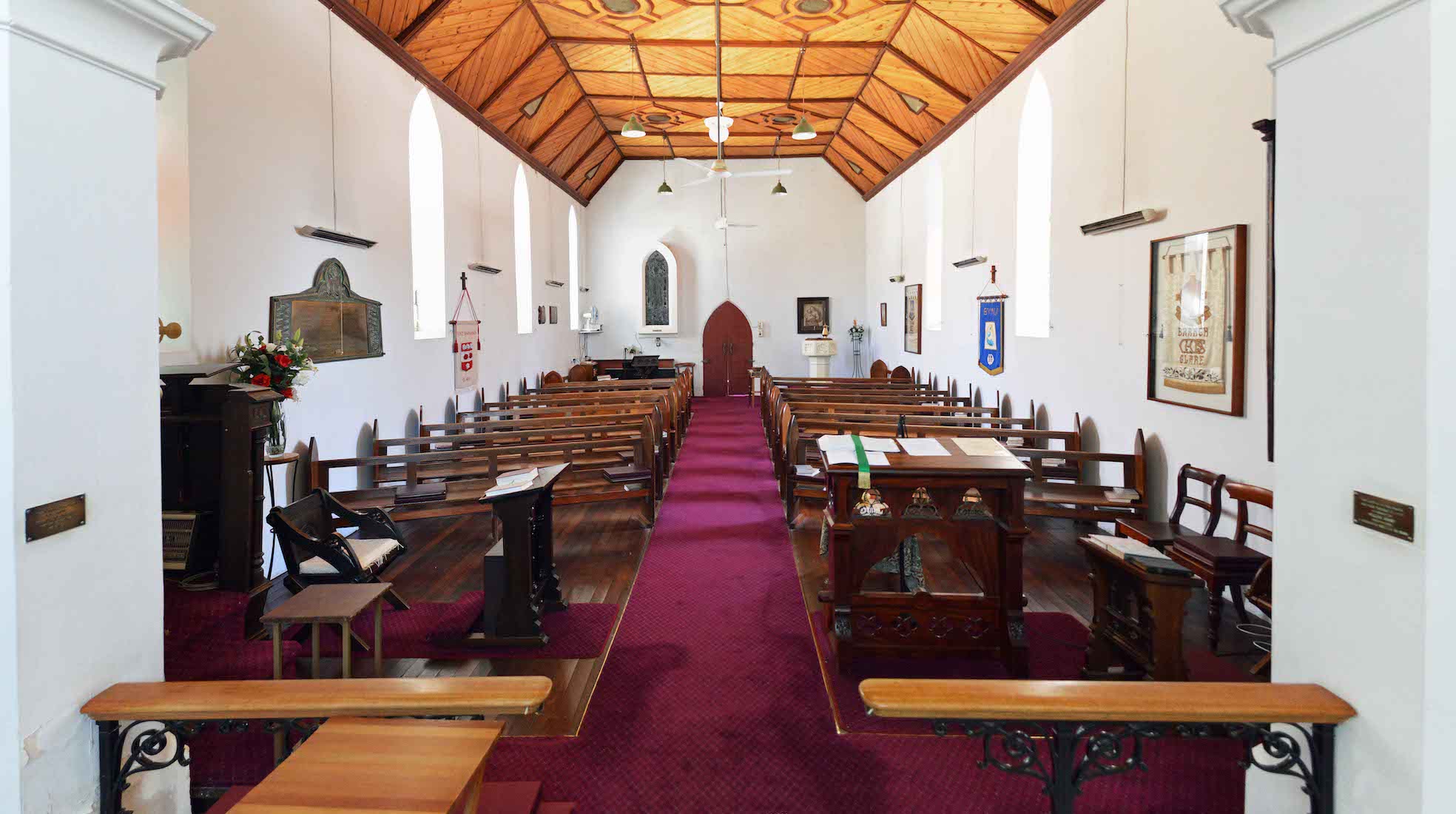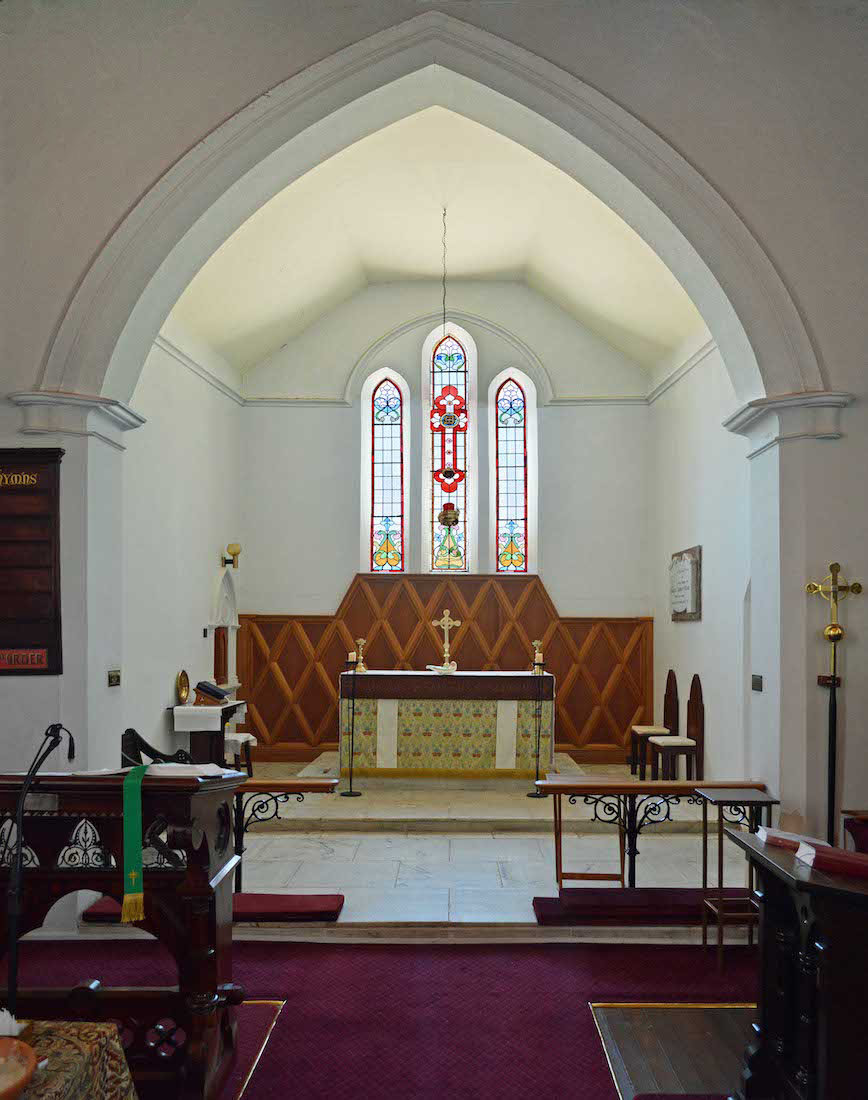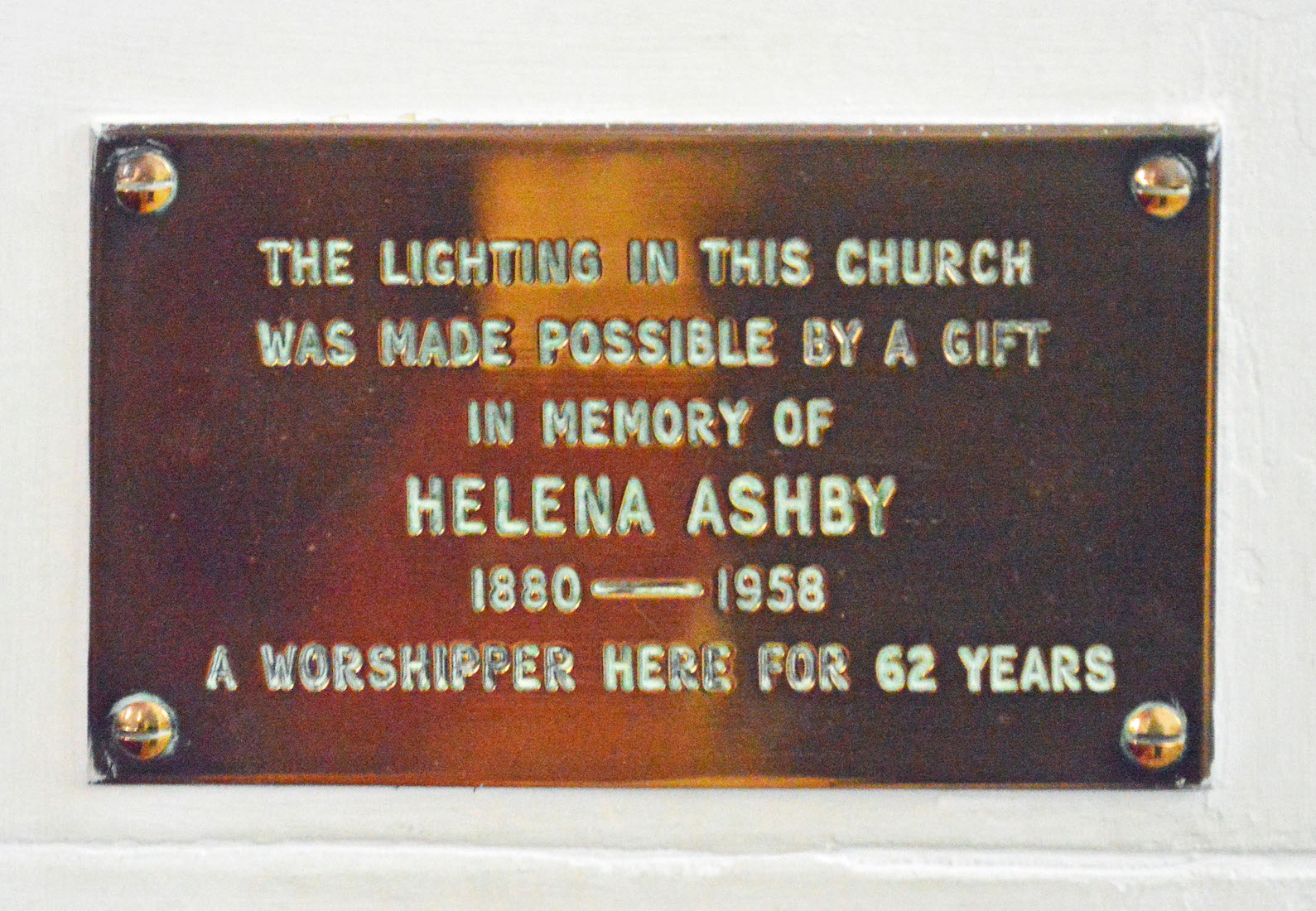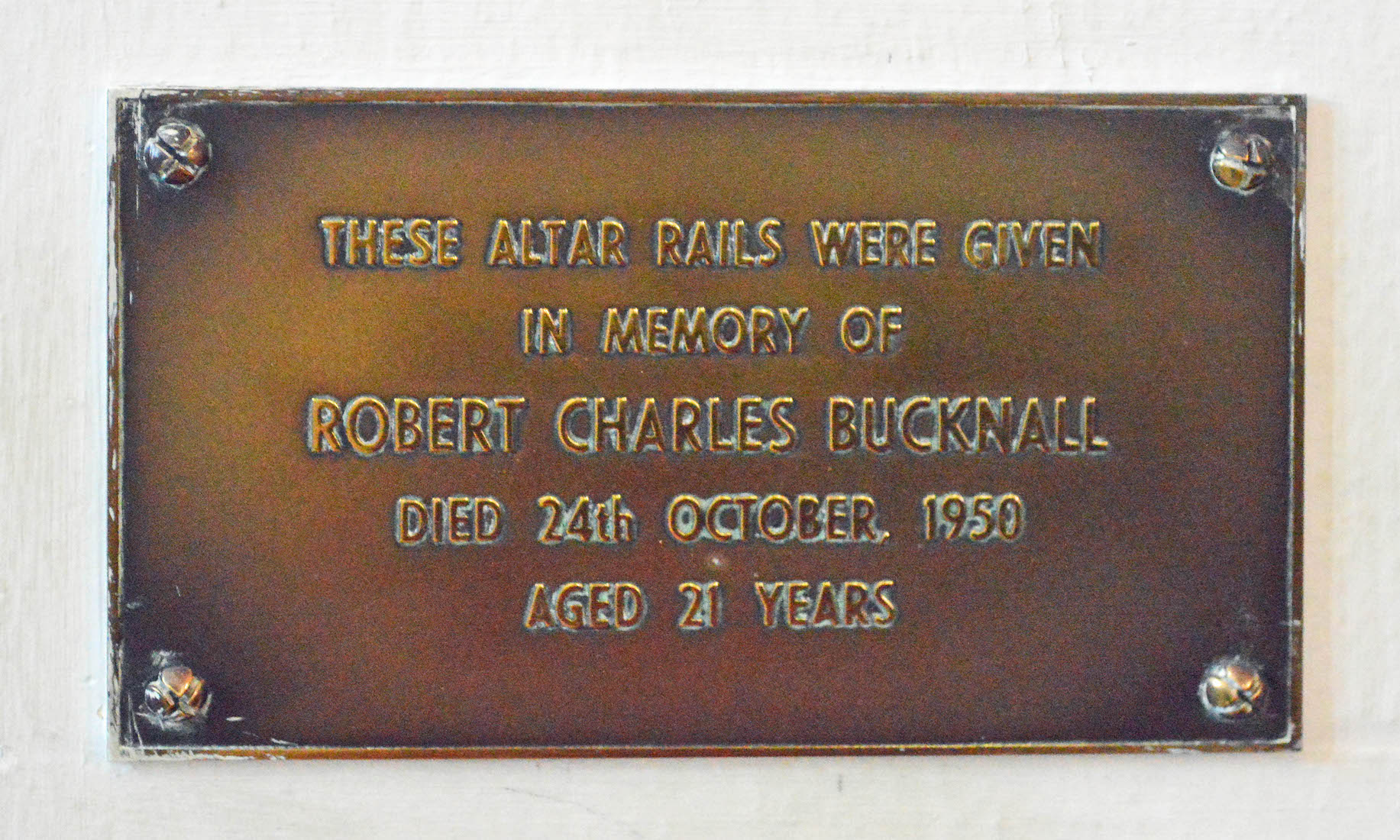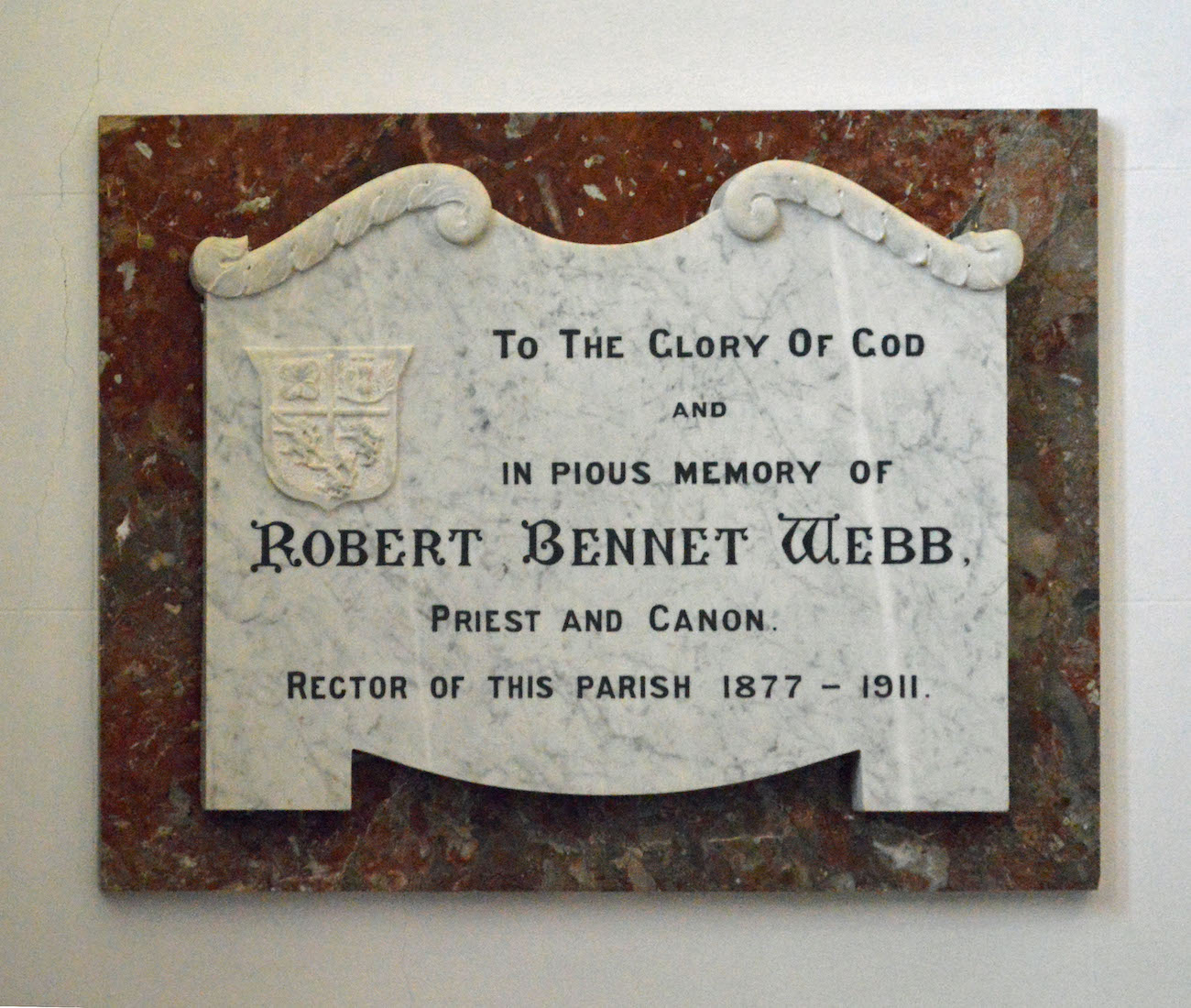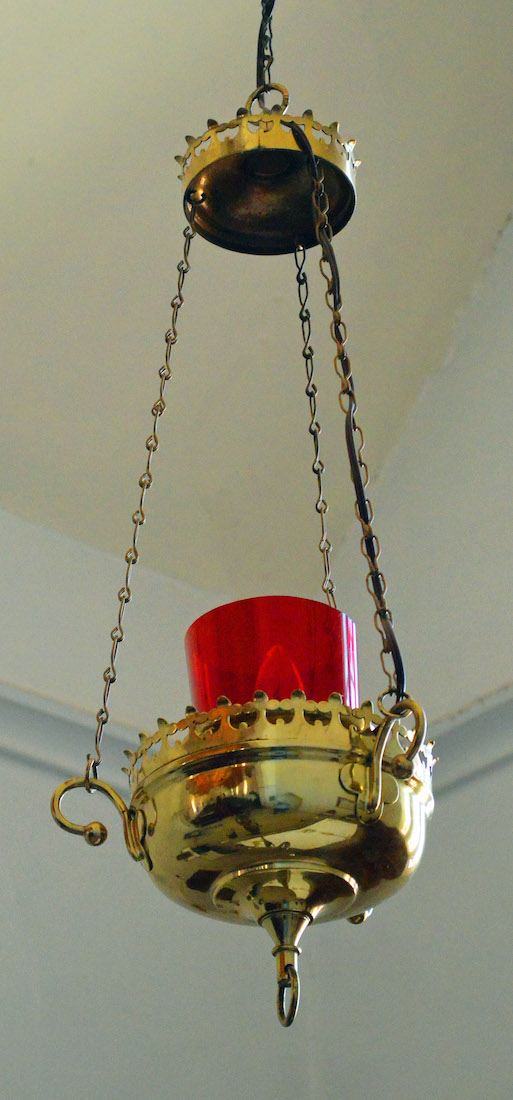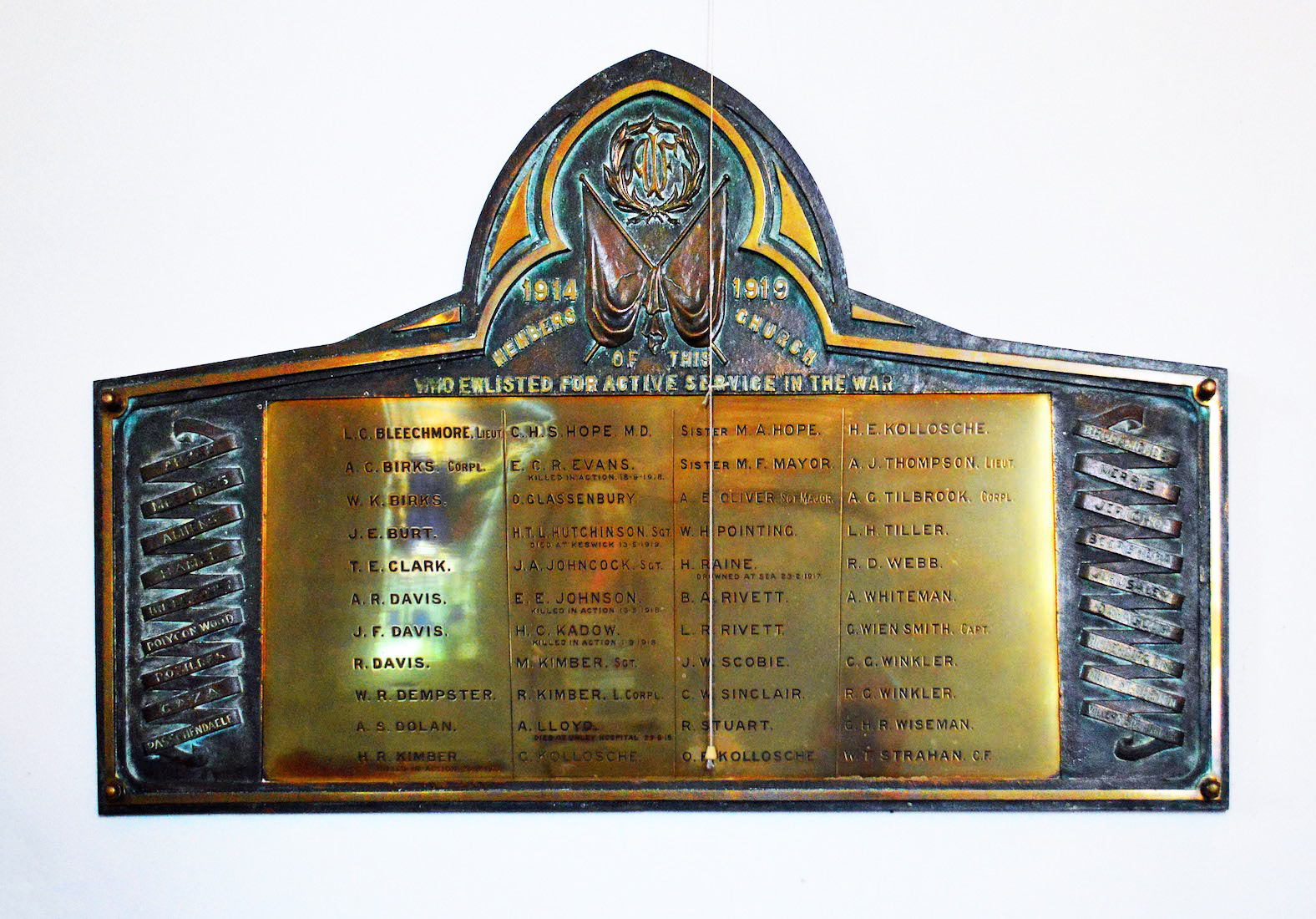
The Honours Roll lists members of the Church who enlisted for active service in the 1914–1918 War. Down either side of the brass plate is a descending ribband with battle honours.
Left Ribband: ANZAC, MESSINES, AMIENS, HAMEL, BULLECOURT, POLYGON WOOD, POZIERES, GAZA, PASSCHENDAELE;
Right Ribband: BROODSIENDE, MERRIS, JERICHO, BEERSHEBA, JERUSALEM, DAMASCUS, HINDENBURG LINE, MONT ST QUENTIN , VILLERS BRETONNEUX. INDEX
22. BANNER, ROLL, AND PLAQUE
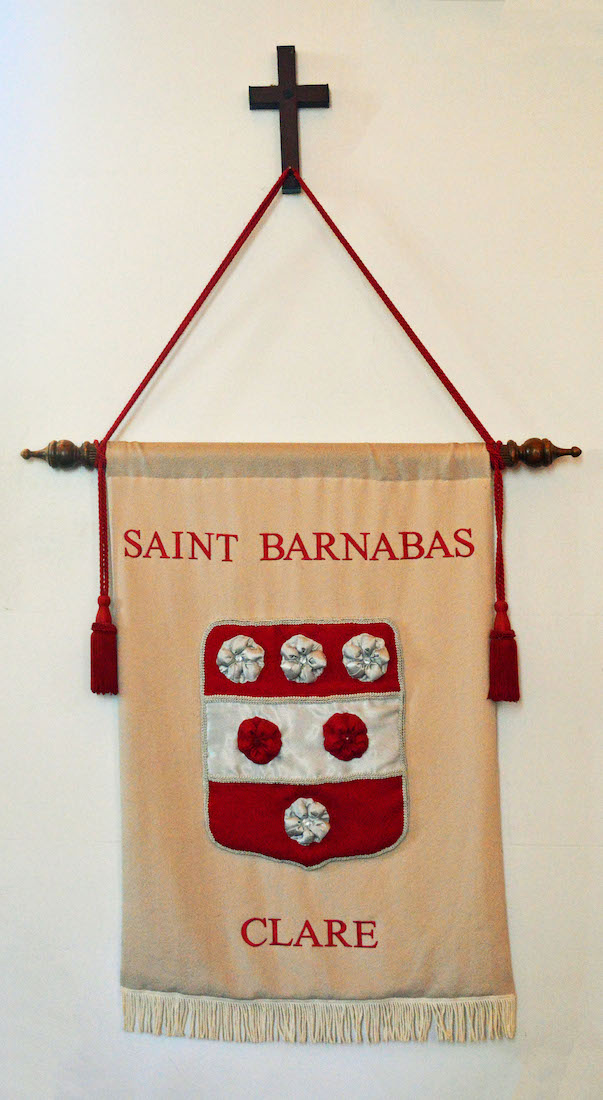
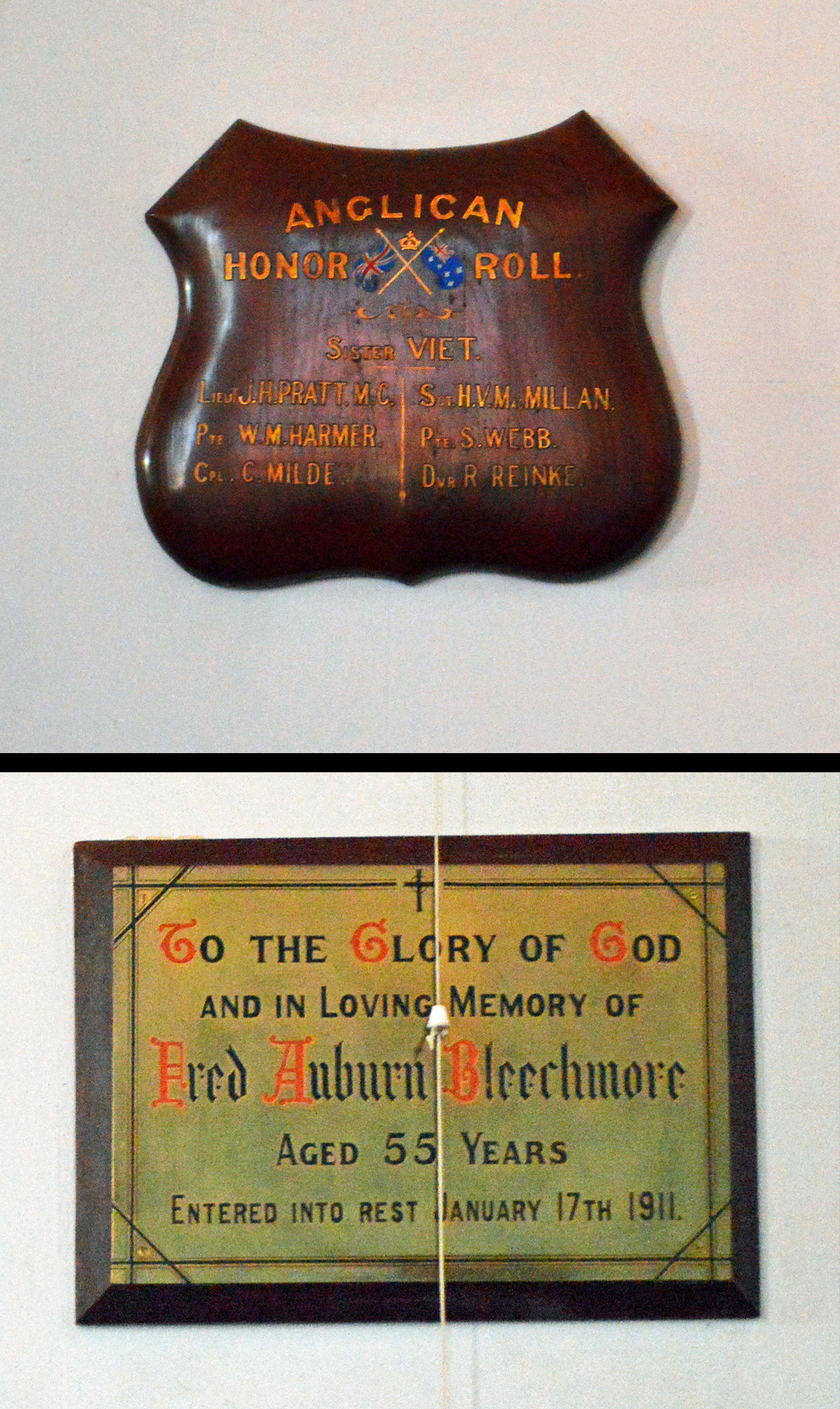
Moving along the South wall, we come first to the St Barnabas banner. St Barnabas was an important early Christian missionary and one of the Apostolic Fathers. The name ‘Barnabas’ means ‘son of encouragement’, and this meaning is conveyed through the colour yellow. The banner is adorned with six roses — four silver and two red. The symbol of the rose comes from a tradition at St Barnabas’ Feast Day in England, where boys and girls would garland themselves with roses in full bloom. • The memorial reads: ‘To the Glory of God and in sacred memory of Fred Auburn Bleechmore, Aged 55 years. Entered into rest January 17th 1911.’
23. SOUTH WINDOWS
There are two stained glass windows on this wall of the nave. At left a window depicting ‘Hope’ is in memory of John Hope and his wife Isabella Matilda. • The window at right shows Jesus with some children under the text Matthew19:14 : ‘Suffer the little children to come unto me’. The window was given in memory of (Rector Rev) Robert Bennett Webb 1877–1911 (years of ministry), by those whom he baptised. Suffer the Little Children to Come Unto Me. Window in memory of Robert Bennett Webb, created by Messrs Vosz.
“On Sunday morning a memorial window was unveiled in St. Banabas' Church, Clare, The window was given in memory of the late Canon Webb by many of the 600 children whom he baptised during his 34 years' incumbency of Clare. The subject depicted is that of Christ blessing little children. The window was unveiled by Mary Ada Tilbrook, who aged at 3years, was the last child baptised by Canon Webb before his death in 1911.” [Advertiser 4 Sep 1913]
24. REAR LECTERN
At the rear of the nave on this side is a nicely carved lectern, which is obviously used.
25. WEST WALL
Across the West end of the nave we have at left a curiously mounted St Barnabas window, and at right a baptismal font with two pictures hanging nearby. There was originally another window in the Northwest (right) corner, but at some point the wall at ths corner required rebuilding, and the window was sacrificed.
26. ST BARNABAS WINDOW
This window came from St Edmund’s Anglican church in Booborowie, a district some 100 km north of Clare. The window had been given in memory of William Pitt Barker, and was created by Powell. After St Edmund’s Church closed, the window was presented in 2011 by the Duggin family to the St Barnabas Anglican Church in Clare. [Photos Credit: aquilareen]
28. SISTINE MADONNA
The mono-colour painting hanging close to the font is a reproduction of a portion of ‘The Sistine Madonna’, an oil painting by the Italian artist Raphael. The painting was commissioned in 1512 by Pope Julius II for the church of San Sisto, Piacenza, and probably executed c. 1513–1514. The canvas was one of the last Madonnas painted by Raphael. Giorgio Vasari called it ‘a truly rare and extraordinary work’. Raphael’s original painting can be seen here.
29. PORTRAIT AND MEMORFIAL
Also hanging near the font is this unidentified portrait – perhaps Rev Bagshawe, architect and first rector of St Barnabas’ Church. The little plaque on the font remembers Anne Webb, wife of (Reverend) Robert Bennett Webb, who fell asleep on Oct 19 1920.
30. NORTH WALL
Along the North wall there are three banners, and three lancet windows – two having stained glass.
31. NORTH WINDOWS
The window at left depicts Christ and his apostles. The window is in memory of Enid Frances Sladen Hope (1884 –1932), donated by her sister Dorothy Frazer. A newspaper extract of the time reads: ‘HOPE. — On the 15th November [died] at ‘Wolta Wolta’, Clare, Enid Frances Sladen, dearly beloved wife of R. E. H. Hope.’ [Advertiser 16 Nov 1932] • The central, largely clear window, is one of several identical windows found in the Church. • The third window has the theme of Faith. This window is in memory of John Christison. A newspaper report reads: ‘At St. Barnabas’s Church yesterday morning two stained glass windows were unveiled. ... The windows, which represent Hope and Faith, are the gift of Mrs. J. Christison, one in memory of her father and mother, and the other of her husband.’ [Observer 28 Mar 1914]
32. BANNERS
The two banners shown at right are for the Mothers’ Union, a world-wide Anglican organisation with more than four million members. The banner at left is of the Church of England Missionary Society. This was founded in 1799 by a group of philanthropists, including William Wilberforce, the Society was created to take the Gospel message to all the world, and to campaign for the abolition of slavery.
33. NORTHEAST CORNER
In the Northeast corner of the nave stands a sturdy lectern. On the wall behind is a hymn board, and one of the tablets of the Law we have already looked at.
34. LECTERN
Whereas the pulpit is used for preaching the Gospel, the lectern is the place from where the Scripture is read. This would also be used for reading out notices and announcements.
35. NAVE LOOKING WEST
Before we turn to the sanctuary, we can look back over the nave, and recall all the items we have looked at so far.
36. SANCTUARY
We turn to the sanctuary. Two little brass plates at the sides near the front, a retable and aumbry on the left wall, a larger plaque on the right wall, a sanctuary lamp above, and the East window behind the altar and reredos. The aumbry is the little cupboard in the North wall close to the reredos. In here are kept blessed Elements of the Eucharist which can then be taken during the week to sick members of the congregation.
37. SANCTUARY BRASS PLATES
The little brass plates remember parishioners who donated items for the Church building. The lighting was given in memory of Helena Ashby, a worshipper for 62 years, and the altar rails were given in memory of Robert Charles Bucknall, a young man who died in 1950.
38. RETABLE
A retable is a small table which sits to the side in a church sanctuary, and is very useful for placing items during a worship service. Here a Prayer Book, a brass platten, and – signs of the times! – some hand sanitiser.
39. WEBB MEMORIAL
The plaque on the South side of the sanctuary remembers Robert Bennett Webb who was Rector of this parish from 1877 to 1911. Webb had a long ministry here, during which he baptised 600 children, and was obviously much loved.
40. SANCTUARY LAMP
The sanctuary lamp hangs above the sanctuary. Strictly the light is intended to indicate the presence of The Blessed Sacrament in the aumbry, but these days many parishioners take it to indicate the Presence of God – not a bad thing!



